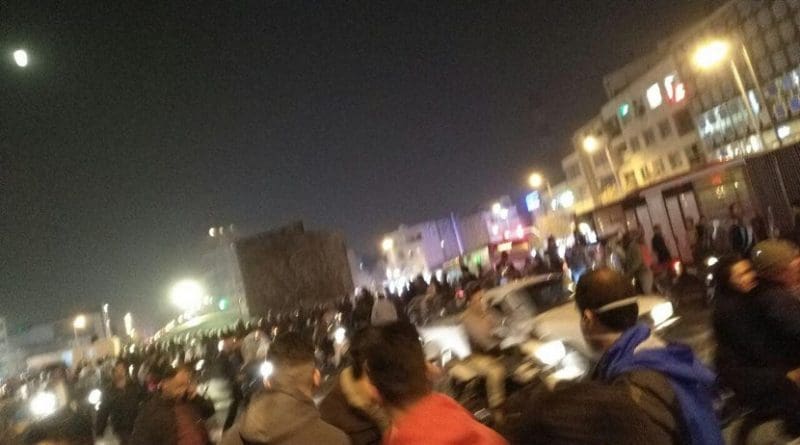Iran Protests: Drivers And Consequences – Analysis
By IPCS
By Majid Izadpanahi*
While much of the world was busy celebrating the new year, Iran was enveloped in protests. Spread across 70 cities, these protests began in the Shiite holy city of Mashhad in reaction to endemic inflation that has plagued the Iranian economy.
This demonstration was more significant than the Green Movement in 2009 or any previous demonstrations Iran has faced. Firstly, the Green Movement opposed the election of Ahmadinejad and was driven by the participation of the middle class and restricted to three or four large cities with a clear slogan, “Where Is My Vote?” This protest was much more widespread, targeting external policies perceived to have a direct influence on the current economic downturn and hence the average Iranian’s standard of living.
These policies include Iran’s involvement in Syria, Lebanon and Gaza, leading to slogans like “Let Go of Syria, Think of Us,” or “No Gaza, No Lebanon, My Life for Iran.” Secondly, this protest was spontaneous, organised through the Internet – specifically a messaging application called Telegram – without leadership, and lacked the support of the established reformists as some of these voters have lost their faith in them and President Rouhani. Surprisingly, two conservative and religious cities – Mashhad and Qom – witnessed anti-Islamic Republic and pro-Iranian royal family slogans.
Though triggered by inflation, there are many factors motivating the demonstrations: inflation, unemployment, pervasive corruption and embezzlement, to name but a few. These causes absorbed the nationwide protest organised a few months earlier by people who lost money invested in financial institutions that became bankrupt. These earlier protests led by the normal salaried class comprising a spectrum, from teachers, to bus drivers and labourers, intensified after the earthquake in Western Iran and the lack of governmental aid to the survivors.
Protestors were further aggravated when President Rouhani allocated more funds for religious institutes than other crucial administrative organisations, such as the Organisation of the Environment, which looks after Iran’s many environment-related problems. In short, these protests represent a far wider cross-section of the population than previous protests.
The Government’s Approach
While officials accepted the right to protest and admitted to the existence of economic problems, they accused foreign powers – Saudi Arabia, the US, and Israel – of instigating the demonstrations. Consequently, the government response was three-fold: force, counter-propaganda, and censorship. Riot police was used to crack down on and arrest protestors.
The counter-narrative of a foreign hand was created, stoking nationalist sentiments through mass media and organised pro-government demonstrations. Finally, apps like Telegram, Instagram and Facebook were blocked.
Consequences
All of this leads to two main questions relating to the durability of the protests, and their consequences.
The demonstrations began based on economic motivations but very soon turned into political demands as they correctly blamed the officials’ inability to solve problems. Signs of confusion among Iranian officials over the state of affairs are visible. They failed to grapple with the demands of the demonstrators and resorted to deflection tactics accusing other countries. As long as the disillusionment with the economic function of the government and the grounds for discontent exist, the possibility of recurrent protests remains open.
While previous protests had been supported by reformists within Iran, the current demonstrations can be considered a third force outside the established political system, and beyond the reformist-fundamentalist equation. In fact, this third pole has pushed the reformists and fundamentalists closer to each other, possibly leading to the emergence of a new pro and anti-government equation. In other words, a new political makeup.
Overplaying the foreign conspiracy angle may undermine President Rouhani’s détente foreign policy and bring about a new round of tensions between Iran and the West. The US is planning new political sanctions on Iran due to “the violation of human rights.” The continuation or recurrence of the protests may prevent foreign investments in Iran, especially in the energy sector, preventing any short-term bubbles or deeper economic recovery.
Ultimately, if these protests achieve political amplification well beyond their current significance, the consequences will depend entirely on the reaction of the government to them.
* Majid Izadpanahi
Postgraduate scholar, Centre for Energy Studies, Masaryk University, Czech Republic

